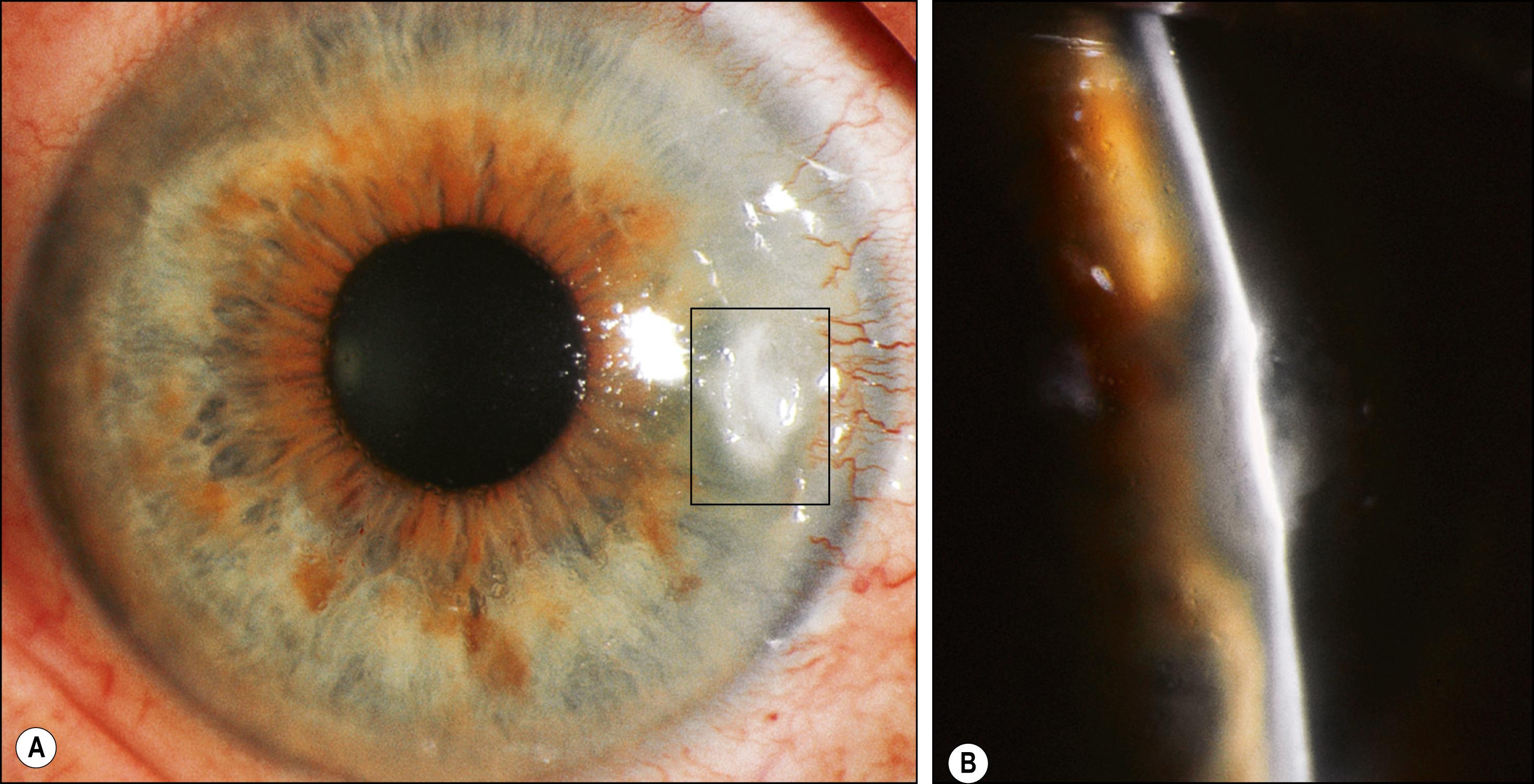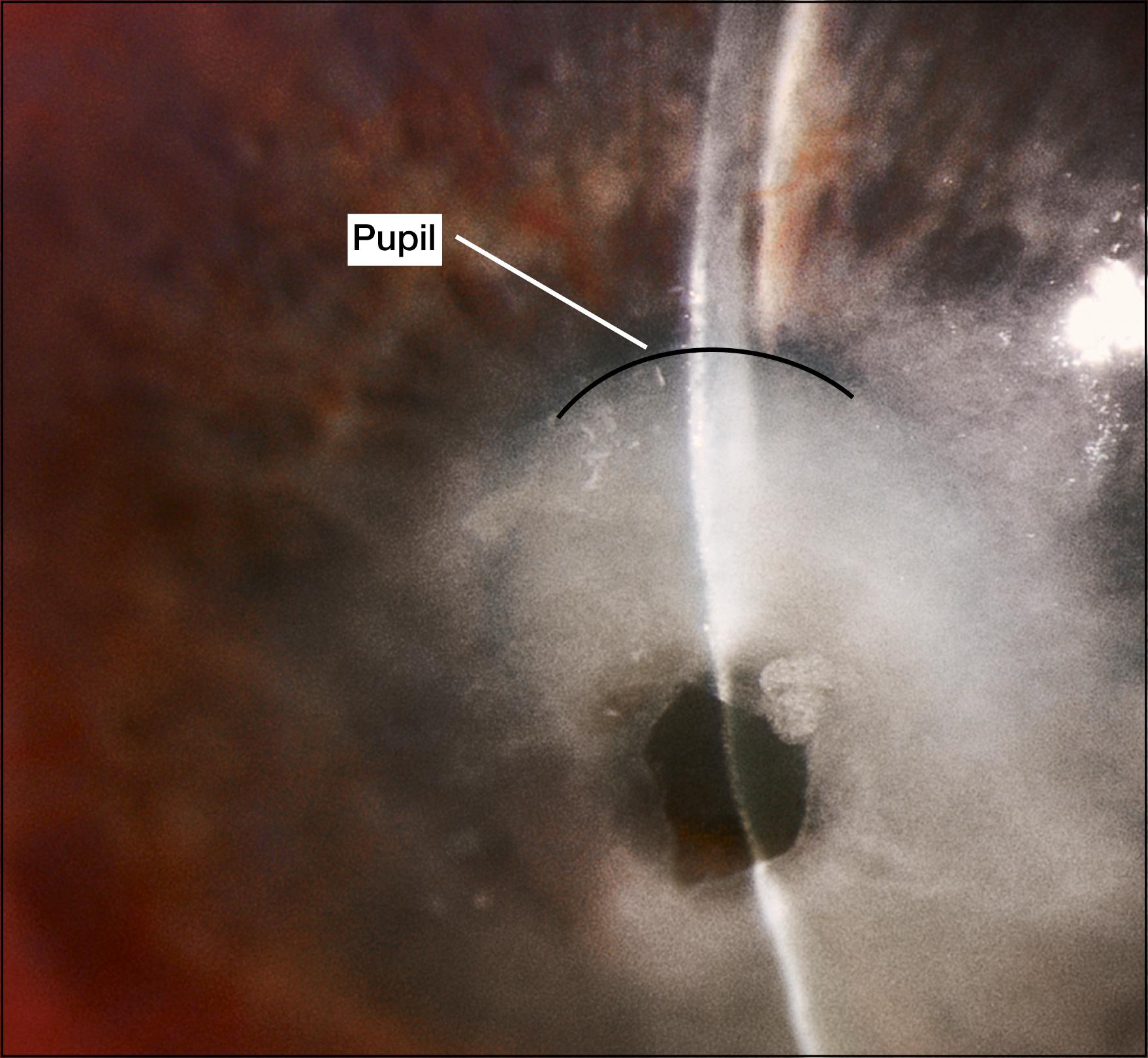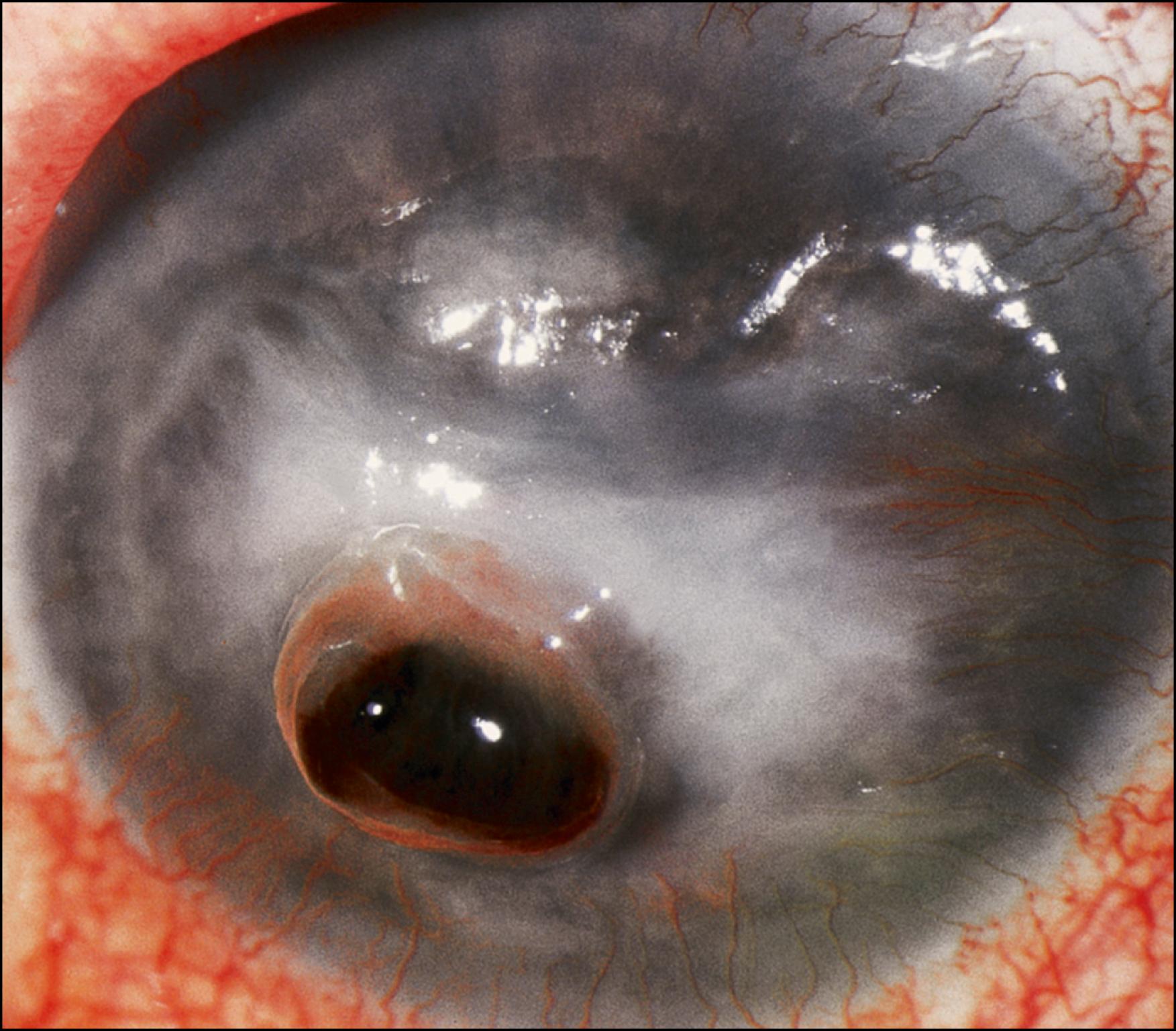Physical Address
304 North Cardinal St.
Dorchester Center, MA 02124
Prevention of corneal perforations is of paramount importance.
Aggressive lubrication, punctal occlusion, bandage soft contact lenses, tarsorrhaphy, amniotic membrane tissue, and conjunctival flaps may help prevent impending perforations from perforating.
Corneal perforations are ophthalmic emergencies that may require immediate surgical repair in the operating room.
Etiology and size of the perforation help direct treatment.
Small (<1−2 mm diameter), relatively central perforations are typically best managed using cyanoacrylate tissue adhesive.
Larger perforations may require patch grafts, tectonic patches, amniotic membrane transplantation, Descemet membrane endothelial keratoplasty, or penetrating keratoplasty.
Corneal perforations can result from a variety of disorders and can lead to devastating visual sequelae. Descemetoceles and perforations are ophthalmic emergencies that require immediate recognition and intervention. The primary causes include infection, inflammation, and trauma. However, other conditions such as exposure and neurotrophic keratopathy, xerosis, and corneal degenerations can also cause ulceration and perforation ( Box 140.1 ).
Infectious (bacterial, fungal, viral [herpes simplex, varicella-zoster], parasitic)
Inflammatory (collagen vascular disease, acne rosacea, atopic disease, granulomatosis with polyangiitis, Mooren [idiopathic] ulcer)
Trauma (chemical, thermal, ultraviolet [UV], penetrating)
Xerosis (idiopathic, Sjögren syndrome, Stevens-Johnson syndrome, ocular cicatricial pemphigoid, vitamin A deficiency)
Exposure (seventh nerve palsy, thyroid-related ophthalmopathy, ectropion, floppy eyelid syndrome)
Neurotrophic (postviral, tumor, trauma, postsurgical [cataract extraction, penetrating keratoplasty])
Degeneration/ectasia (Terrien marginal degeneration, keratoconus, keratoglobus, pellucid marginal degeneration)
Surgical (cataract extraction, LASIK, standard PRK, epithelial sparing PRK, pterygium excision with mitomycin C, glaucoma filtering/shunt surgery)
Toxic/keratolytic (topical NSAIDs, topical antibiotics, topical corticosteroids, silicone oil, chemotherapy agents, herbal medications)
Management should be directed toward prevention of corneal perforation, because once a perforation has occurred, the visual outcome is often disappointing. Recognition of the conditions leading to perforation and management of the perforated cornea are discussed. Treatment of traumatic perforations is not discussed in depth here because this topic is covered in great detail in other chapters.
The most common cause of corneal perforation is infection, either bacterial, fungal, or viral. Infection accounts for between 24% and 55% of all perforations, with bacterial infections being most common. A frequent predisposing factor leading to these and other types of perforations is breakdown of the corneal epithelium. Once this barrier is compromised, the pathogen gains easy access to the stroma, inciting an inflammatory response in the host. Damage results from a combination of direct microbial invasion and, more importantly, through host chemotaxis of leukocytes, causing collagenases to be released and corneal ulceration to occur. Viral keratitis, primarily herpes simplex virus (HSV) and varicella-zoster virus (VZV), may lead to corneal perforation secondary to recurrent active ulcerative keratitis, persistent epithelial defects, and neurotrophic keratopathy. Fungal infections are less common and often progress more slowly than other forms of infectious ulcerative keratitis, but nonetheless may lead to corneal perforation.
Inflammatory conditions such as collagen vascular diseases (e.g., Sjögren syndrome), acne rosacea, granulomatosis with polyangiitis (Wegener granulomatosis), and Mooren (idiopathic) ulcer can also cause peripheral, and occasionally central, ulcerative keratitis and subsequent perforation. The use of topical corticosteroids, topical antibiotics, and topical nonsteroidal antiinflammatory drugs (NSAIDs) may exacerbate or initiate a stromal melt in the presence of some of these disorders, but perforation can also occur spontaneously. , Herbal medicines used in developing countries have been implicated in melts and perforations as well.
Trauma—chemical, thermal, surgical, or penetrating—is also a common cause of corneal perforation. Chemical injuries, alkali burns in particular, may cause devastating corneal damage, initially by direct tissue destruction and later by induction of stromal melting and necrosis because of the elaboration of collagenases. Some chemotherapeutic agents used topically such as 5-fluorouracil, mitomycin C, and the systemic anticancer drugs, S-1 20 and erlotinib, have been reported to cause perforation. Thermal and ultraviolet (UV) radiation-related injury normally causes superficial corneal damage but may, in rare instances, cause perforation because of extreme heat, UVB damage, or associated mechanical injury. , Corneal ulceration and perforation have also been reported after cataract extraction, both with and without intraocular lens implantation, , laser in situ keratomileusis (LASIK), phototherapeutic keratectomy (PTK), pterygium excision with use of mitomycin C, , and rarely after argon laser photocoagulation and silicone oil placement in the eye.
Xerosis and exposure keratopathy are also causes of corneal perforation. Xerosis may be idiopathic; related to collagen vascular disease (e.g., Sjögren syndrome); or secondary to Stevens-Johnson syndrome, ocular cicatricial pemphigoid, ichthyosis, or vitamin A deficiency. Exposure may result from seventh nerve palsy, thyroid ophthalmopathy, involutional ectropion, floppy eyelid syndrome, or chronic cicatrizing eyelid disorders.
Neurotrophic keratopathy is most commonly encountered after a viral infection, typically HSV and VZV, as well as secondary to tumor, trauma, or surgery (e.g., penetrating keratoplasty, cataract extraction, LASIK). The lack of corneal sensation leads to chronic epithelial breakdown with poor healing. This persistent epitheliopathy makes the cornea susceptible to a sterile melting process or infectious keratitis and potential perforation.
Corneal degenerations such as Terrien marginal degeneration can lead to slow, progressive thinning, which rarely proceeds to perforation. , Corneal ectatic disorders such as keratoconus, keratoglobus, or pellucid marginal degeneration may present with extreme thinning and ectasia. Perforation in these situations is exceedingly rare but can occur as a result of minor trauma, especially in keratoglobus, and has also been reported in pellucid marginal degeneration. Corneal rupture and fistulization after acute hydrops in keratoconus are also uncommon but have been described. ,
The terminology of corneal ulceration, descemetocele, and perforation can be confusing and is often misunderstood. It is important to clearly define these terms. A corneal ulcer refers to a defect in the epithelial layer with some degree of stromal loss, often with infiltration or necrosis ( Fig. 140.1 ). A descemetocele refers to a lesion in which there is destruction of the epithelium and stroma, with only the Descemet membrane and endothelium remaining ( Fig. 140.2 ). Because of its highly elastic nature and the intraocular pressure, the Descemet membrane often bulges anteriorly, forming the classic dome-shaped, transparent membrane, which is easily recognized at the slit lamp ( Fig. 140.3 ). At this stage, the cornea is in imminent danger of perforation.



A cornea that has thinned to the level of the Descemet membrane but contains an epithelialized surface is best described as a healed descemetocele and is at much less risk for further ulceration and perforation. The term impending perforation is less specific but typically refers to any ulceration with severe stromal thinning that clinically appears capable of perforating in the near future. Perforation refers to a situation in which there is a definite full-thickness defect in the cornea and there is communication between the anterior chamber and surface of the eye. A descemetocele through which aqueous is percolating is technically a true perforation, but is often referred to as a leaking descemetocele . Regardless of terminology, any nonepithelialized, severe thinning of the cornea must be treated as a therapeutic emergency that requires prompt intervention.
The majority of patients with a leaking descemetocele or corneal perforation experience an abrupt decrease in visual acuity with associated pain; however, the clinical presentation can be quite variable. Ulceration and perforation in a previously healthy eye may cause the patient to notice the acute onset of symptoms sooner than in a sick or infected eye, which may already have poor visual acuity and discomfort. Similarly, a neurotrophic eye may not sense any change in symptoms, other than possibly a change in visual acuity or sudden tearing.
Painful symptoms may be attributable to ocular surface disease or to deeper pain secondary to iris or ciliary spasm or hemorrhagic choroidal detachments from rapid decompression of the eye. Acute perforations may also cause a sudden loss of aqueous, which the patient may simply dismiss as excess tear production. Patients at high-risk for perforation should be made aware of the possible symptoms and told to seek immediate ophthalmic attention if any of them occur. In eyes with extremely thinned corneas, wearing a shield or glasses during the day and shield at bedtime should be recommended.
The ophthalmologist examining a patient with a suspected descemetocele or perforation must treat the situation similarly to that of an open globe from other causes. The patient should be discouraged from squeezing during the examination, and minimal manipulation of the globe and minimal application of topical medications should be performed. A careful medical and ophthalmic history should be obtained to help determine the etiology of the perforation.
The most common signs of corneal perforation are a flat or shallow anterior chamber, positive Seidel test, uveal prolapse, and hypotony. Examination may reveal an obvious perforation with the above signs; however, in many situations, signs of perforation may be more subtle. Uveal prolapse may plug a wound, causing re-formation of the anterior chamber and a negative Seidel test. Applying gentle pressure from above or below often may yield a positive Seidel sign, which is not present without any external manipulation. If the anterior chamber is completely flat, the Seidel test is often negative, even in the presence of a frank perforation. These characteristics are summarized in Box 140.2 .
Pain
Decreased visual acuity
Increased “tearing”
Shallow or flat anterior chamber (perforation)
Positive Seidel test (perforation)
Uveal tissue to the posterior cornea or frank prolapse (perforation)
Hypotony (perforation)
Central clear zone (often bulging) within area of infiltrate or thinning (descemetocele)
Radiating folds in Descemet membrane emanating from the base of the ulceration (descemetocele)
Infectious ulcers with a significant amount of purulent material and mucus can be difficult to evaluate for a perforation. If a central clear zone exists within a large, dense infiltrate, then a perforation or descemetocele should be suspected. Any shallowing of the anterior chamber on sequential examinations in the absence of high intraocular pressure and pupillary block is presumptive evidence of perforation. The presence of a hypopyon that suddenly clears on subsequent reexamination should also raise one’s suspicion that a perforation has occurred. In an impending perforation, the only sign may be radiating folds in the Descemet membrane emanating from the base of the ulcer. This sign may be particularly helpful in cases in which the infiltrate and necrotic stroma obscure the view.
An intact epithelium does not imply that a corneal perforation has not occurred. Chronic perforations with uvea or other material plugging the wound can reepithelialize spontaneously. These cases sometimes require intervention; however, because the epithelium provides a moderately effective barrier to infection, repair, if needed, can be performed on an urgent rather than emergent basis, and in some eyes may not be required. After a suspected perforation is confirmed at the bedside or slit lamp, attention should then be directed to repair and restoration of the integrity of the globe as soon as possible.
After a perforation is detected, the ophthalmologist must then determine whether correction of the problem can be accomplished as an inpatient or outpatient, whether it can be performed at the bedside or slit lamp, or whether surgical intervention in the operating room is warranted.
If surgical repair is definitely indicated, the patient should not receive food or drink by mouth, and a determination should be made of the last time food or drink was ingested. In the presence of infection, systemic antibiotics (most commonly moxifloxacin but occasionally cefazolin and gentamicin, or ceftazidime) are administered, beginning as soon as possible and continued for at least 24–72 hours. In general, perforated ulcers and descemetoceles thought to be infectious in origin should be gently cultured. If the perforation is thought to be sterile or the patient cannot be admitted to the hospital, an oral fluoroquinolone (most commonly moxifloxacin) may be used prophylactically. A shield should be placed over the eye and manipulation on the part of the patient, ophthalmologist, and nursing staff should be kept to a minimum. In general, if the anterior chamber is flat, repair (regardless of method) should be performed within the first 24–48 hours to avoid permanent peripheral anterior synechiae and damage to the cornea, lens, and posterior segment.
Become a Clinical Tree membership for Full access and enjoy Unlimited articles
If you are a member. Log in here